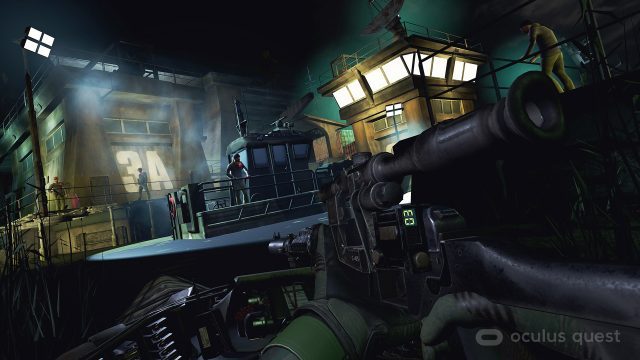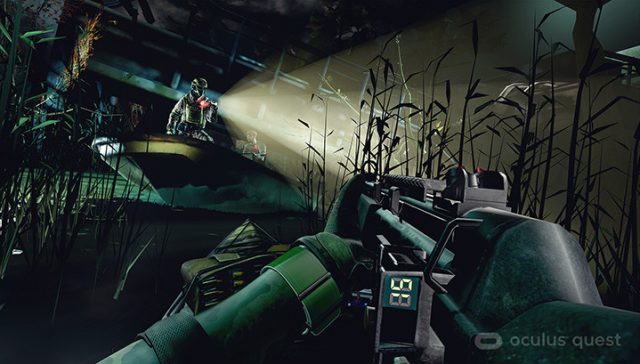At E3 2019 this week, I got a chance to go hands-on with Phantom: Covert Ops, an Oculus Studios exclusive in development by nDreams. The game plays out over the course of a single night, and follows a special operative as they infiltrate a facility in a tactical kayak. While the kayak part sounds just a little ridiculous, it’s actually a genius bit of VR design which affords the game an immersive locomotion and interaction system that has huge potential.
Phantom: Covert Ops is in development for both Rift and Quest. At E3 2019 I got to play the first demo of the title on Quest. The first thing I noticed when I put the headset on was that the game looks surprisingly good for being on Quest. It’s clear that this game was not stripped for all it was worth to meet Quest’s lower powered hardware, but was instead thoughtfully designed with the graphical limitations in mind. Still, I’m excited to see what the game will look like on Rift with the power of a full PC behind it.
After a few minutes into the game, I felt immersed enough that I completely forgot I was even using Quest (or in the middle of a noisy room at E3)—Phantom: Covert Ops feels like a serious game for serious gamers, rather than a casual title for VR first-timers. This is all thanks to the smart locomotion and interaction design of Phantom which revolves entirely around the player covertly infiltrating a facility from the waterways.

nDreams has hit on the same approach to designing Phantom that I regularly rant about on Twitter—find what actually works and is fun to do with a VR headset on your head and tracked controllers in your hands, and then find a way to build your game around it. The all too common alternative in VR development is ‘on-paper design’, whereby someone expects to easily translate well defined non-VR genres into VR without first figuring out if the underlying mechanics that existing in those non-VR games actually make for a fun VR experience. See Lone Echo as one of the finest examples of the former approach, and Déraciné as the latter.
Phantom builds its gameplay around the kayak which serves as both the player’s locomotion and much of their interaction. A paddle stowed on the side of the kayak is used to propel yourself stroke by stroke, and indeed you’ll need to paddle on one side or the other to turn as you navigate the swampy waterways.
When you aren’t paddling, you’ll find the kayak around you equipped with some useful tools. To the right is a silenced rifle, on your chest is a silenced pistol, and on your back is an SMG. On the kayak in front of you there’s a box of unique magazines for each of your weapons, and a box of C4 with a remote detonator.
Using all of these items is so easy and immersive because they’re right there with you all the time—not to mention the fact that locomoting takes two hands, which means shooting while locomoting (which in many games is cumbersome) isn’t really a thing. Instead, you’ll often park your kayak somewhere inconspicuous, and then your hands are free to use the tools in front of you as you see fit. The result turns out to be very immersive.
Gameplay plays out like you’d expect from a stealth shooter—beyond being in a kayak, that is—I paddled my way through dark waterways, trying to avoid being seen by enemies, spotlights, and sometimes boats. There were reeds that I could use for cover, and I could shoot lights out with my silenced weapons to make new pathways of darkness. In many cases there were at least two different directions I could choose to go, some of which had interactive elements blocking the way (like one where I had to pull a chain on a pulley to open a sewer pathway in front of me, or another where I used C4 to blow open a blocked pathway).
The silenced rifle was the most precise killing tool at my disposal, but it consequently comes with the least ammo. Phantom is using an interesting scope mechanic which ‘locks’ to your eye when you raise the gun close enough, blacking out the rest of the world except your view through the scope. It seemed a little odd at first, but it’s much less awkward than many other VR scope implementations, which can be difficult to keep zoomed scopes aligned with your eye, making it quick and easy to use.
Meanwhile, the pistol works well for closer shots, and the SMG appears to be intended as a noisy backup for when you get spotted and need to put enemies down fast. You have a limited number of magazines for each weapon (don’t drop them in the water!), and if you reload a magazine before emptying it, you’ll lose the bullets that were in the previous clip. This is not only realistic, but also means you need to be smart about knowing how many bullets are left in each of your weapons, otherwise you might get caught with your pants down in the middle of a gunfight. Good thing there’s a little digital ammo counter on the side of each gun.

The locomotion and gameplay works very well together, and really does a good job of maintaining immersion. There’s something about using physical motions like paddling to guide your locomotion that just feels a lot more immersive than moving with a stick or a button press. Additionally, the way your weapons and tools are sprawled out around you and always within grasp makes for a very consistent ‘interface’ that’s easy to understand and use. The end result is a feeling of ’embodiment’ that makes way for a strong sense of spatial awareness within the virtual world.
Towards the end of the demo, I was tasked with blowing up some sort of radio beacon. I killed one guy standing near a spotlight, and the shot the light out to open a pathway to slip undetected underneath a walkway suspected over the water. I followed below the walkway to reach the bottom of the radio beacon platform and happened upon a panel that was begging for a C4 charge. After planting it, I took the same path under the walkway to retreat to a safe distance before pulling out the detonator and setting off the fireworks, which brought the mission to a close.
– – — – –
Thanks to its smart VR locomotion and interaction design, Phantom: Covert Ops definitely has big potential. The million dollar question is whether or not nDreams can take this strong foundation and build enough unique gameplay moments on top of it to deliver a satisfying experience from start to finish. What I saw was really quite promising in the context of a single mission, but the gameplay will need to evolve from one level to the next to prevent ‘shoot out the light and slip past the guards’ gameplay from overstaying its welcome.
That will come down to how many intriguing gameplay scenarios nDreams can dream up with the player being stuck in a kayak, and ultimately that means figuring out what interesting ways someone in a kayak can interact with people and things on land. Shooting people and blowing stuff up is a good start, but I’ll be very interested to see what else they come up with and if they can weave an interesting story throughout that goes beyond disembodied dialogue over the radio.
On that front, the game’s developers tell me that there’s more weapons and tools that players will see over the course of the game; while they weren’t ready to say more about future gameplay scenarios, a sly smile on one of them me they’re excited about what’s planned.
Phantom: Covert Ops is due to launch some time in 2019 for Rift and Quest. The specific release date, price, and scope of the game haven’t yet been revealed.







